
Last Tuesday, I found myself staring into my fridge at 12:30 PM, holding a sad container of leftover pasta that looked about as appetizing as cardboard. Sound familiar? That moment of lunch desperation used to happen to me almost daily – until I figured out what was actually going wrong.
Turns out, most of us are approaching lunch completely backwards. We focus on convenience and calories instead of working with our body’s natural rhythms. And if you’re experiencing those dreaded 3 PM energy crashes or constantly stressed about food decisions, your current approach might be fighting against your biology instead of working with it.
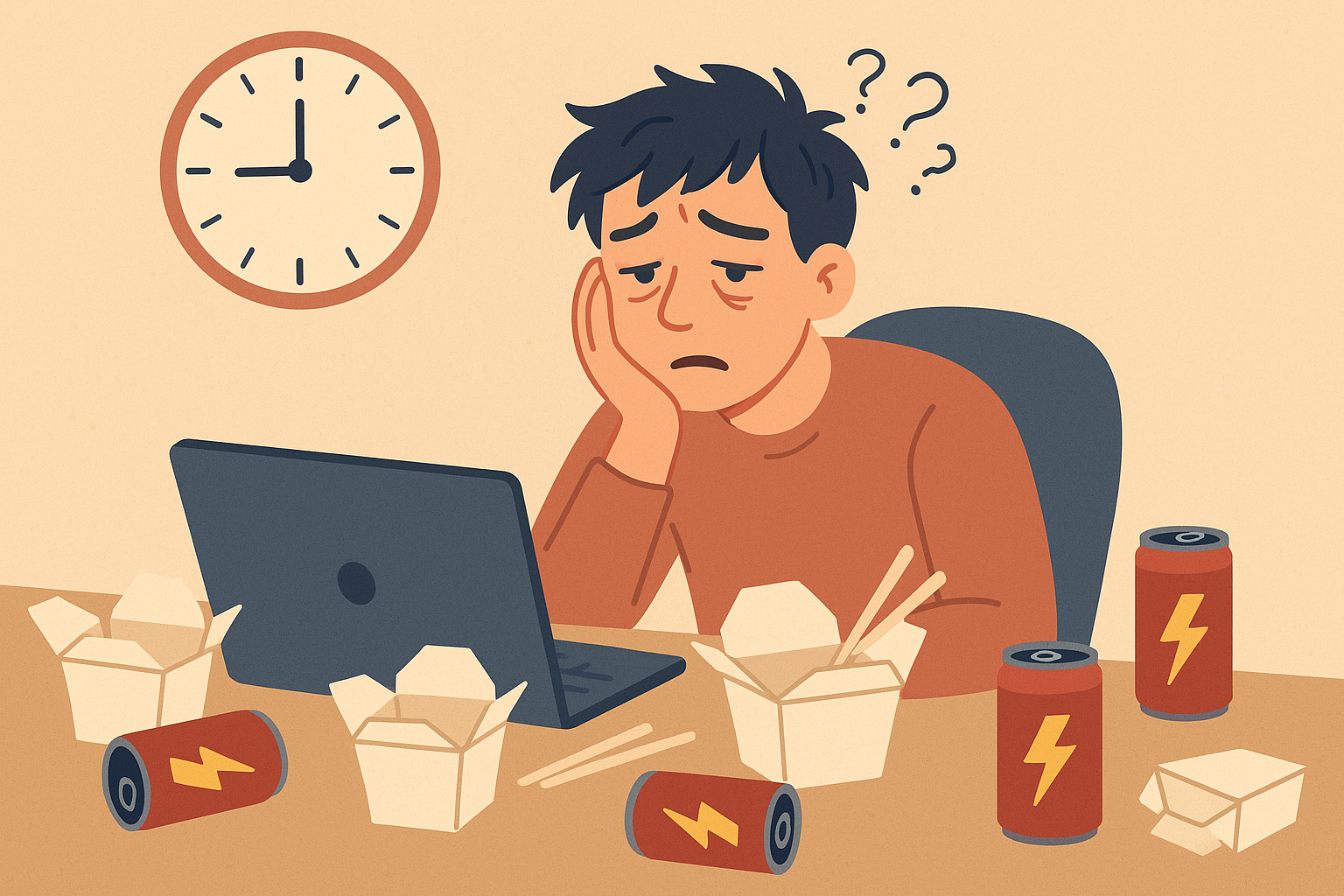
Here’s what I’m going to share: why timing your lunch matters more than what you eat, how to stop stressing about food decisions, and a simple system that actually sticks. No complicated charts or 47-step processes, I promise.
Why Your Body Clock Determines Your Perfect Lunch
I spent years fighting 3 PM energy crashes that left me reaching for whatever sugar-laden snack was closest. Turns out, the problem wasn’t willpower – it was timing.
Your body has a natural rhythm for when it wants food and processes it best. Whether you’re a morning person or night owl dramatically impacts when your body actually craves lunch and what nutrients it can handle during those midday hours.
The breakthrough came when I realized my meal prep strategy needed to align with my natural energy patterns rather than fighting against them. Once I started timing my meals according to whether I was naturally a morning or evening person, those afternoon crashes disappeared completely.
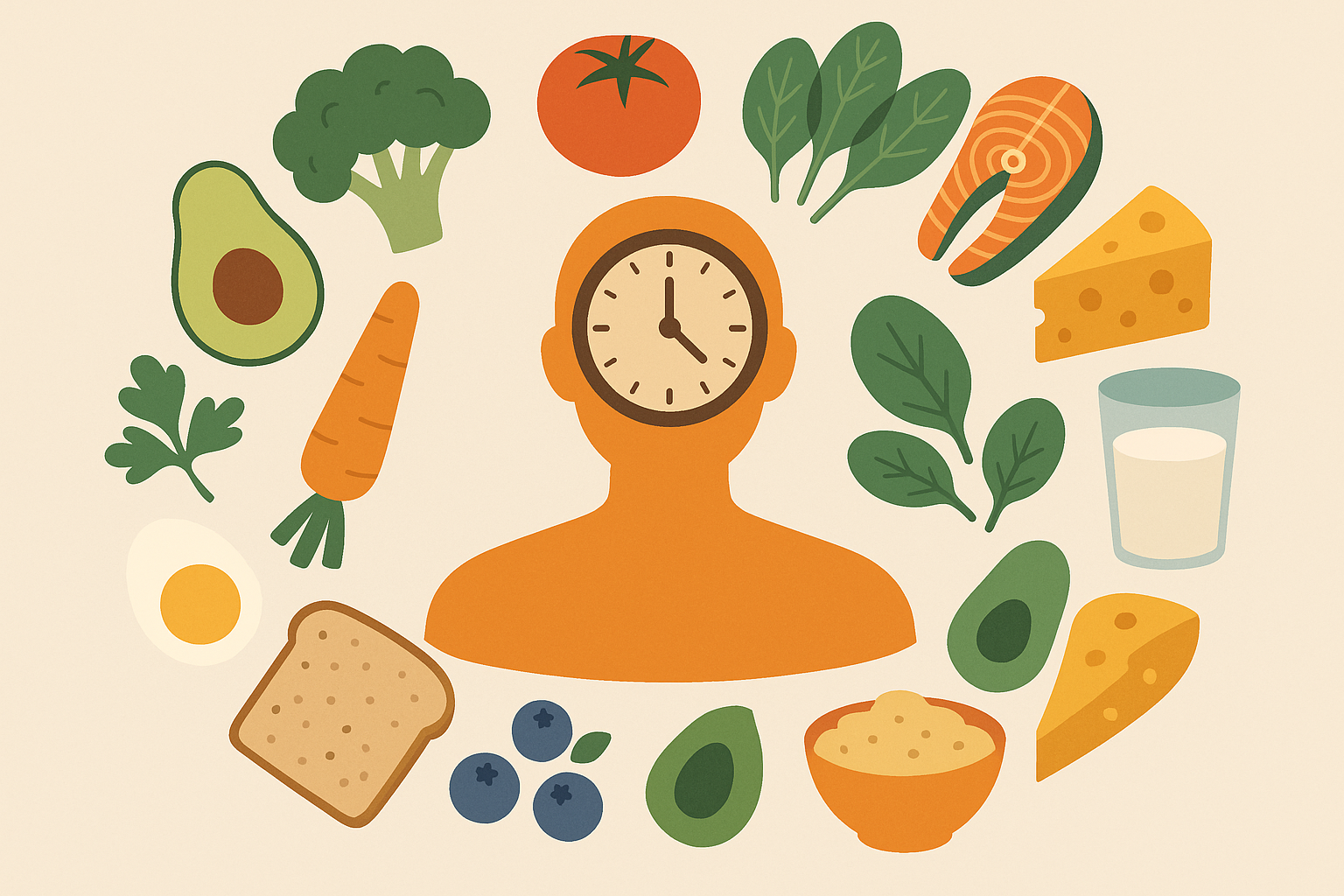
Understanding When Your Body Actually Wants Food
Here’s what I learned: Morning people need lunch earlier (around 11:30) with more protein. Night owls do better eating later (1-2 PM) with more carbs. And if you’re somewhere in between like me? Noon works great with a balanced mix of everything.
I discovered I’m naturally a moderate type, which explained why I felt best eating lunch right at noon rather than the 1:30 PM slot my coworkers preferred. My meal prep routine now centers around having protein-balanced meals ready for that optimal window.
The key is recognizing that your hunger patterns aren’t random – they’re hardwired into your biology. When you meal prep according to your natural rhythm, you’re working with your body instead of constantly battling it.
Here’s what works for different types:
- Morning people: 11:30 AM – 12:30 PM lunch with focus on protein
- In-between people: 12:00 PM – 1:00 PM with balanced protein, carbs, and fat
- Night owls: 1:00 PM – 2:00 PM with more carbs for sustained energy
The Magic Window Between Noon and 2 PM
Between noon and 2 PM, your body naturally processes certain nutrients more efficiently. Your stress hormone cortisol dips while your ability to handle carbs peaks, creating a unique window where your body actually wants food.
I started scheduling my meal prep sessions around this knowledge, preparing lunches that would hit my system during these peak processing hours. The difference in sustained energy was immediate and dramatic.
Fighting Your Schedule Through Smart Eating
Most of us live in constant conflict between our natural sleep-wake cycles and work schedules. Your lunch timing and food choices can actually help realign your internal clock, especially when you’re fighting against your natural rhythm daily.
When I realized my natural bedtime was 11 PM but work demands kept me up until midnight, I adjusted my lunch to include more foods that help with sleep regulation. This simple meal prep modification helped reset my internal clock over time.
Why You Get Sleepy After Lunch (And How to Prevent It)
Post-lunch drowsiness isn’t just about overeating – your core body temperature naturally rises after meals, triggering sleepiness. Certain foods and eating patterns can either make this worse or help you maintain afternoon alertness.
My meal prep ideas now include foods that minimize this temperature spike. I focus on lighter proteins and avoid heavy, warming spices during lunch preparation. The result? No more 2 PM face-plants into my keyboard.
Breaking Free from Decision Exhaustion
You know what’s exhausting? Deciding what to eat when you’re already hungry and stressed. I used to make about 200 food-related decisions daily – no wonder I was mentally fried by lunch.
The constant mental energy required to decide what to eat represents a massive drain on your brain power. This endless cycle of food decisions accumulates throughout the day, leaving you depleted for more important choices and often leading to stress-driven eating patterns.
Students who eat school breakfast achieve 17.5% higher scores on standardized math tests, demonstrating how strategic meal timing directly impacts brain performance – a principle that applies equally to adult lunch decisions.
Now I make maybe 10 food decisions a day, and suddenly I have brain power left for actual work.
Why Too Many Options Make You Miserable
Having endless lunch choices actually decreases satisfaction and increases stress levels. Creating intentional limits through systematic meal prep paradoxically increases both efficiency and enjoyment by eliminating the paralysis of infinite options.
Sarah, a marketing manager I know, reduced her daily food decisions from 15+ to just 3 by creating a rotating menu of 12 lunch templates. She reports feeling 40% less stressed about food and having more mental energy for creative work in the afternoons.
My own meal prep approach follows this principle – I rotate between five core lunch templates, varying ingredients within each framework. This gives me variety without decision overload.
How Your Lunch Choices Shape Who You Become
Every food decision unconsciously reinforces your self-image and future behavior patterns. Strategic meal prep allows you to intentionally align your eating habits with who you want to become, rather than defaulting to whoever shows up when you’re stressed and hungry.
When I started meal prepping, I wasn’t just preparing food – I was practicing being the type of person who plans ahead and takes care of their future self. This identity shift affected decisions far beyond lunch.
Training Your Body Through Lunch
Your midday meal can serve as daily training for your metabolism – your body’s ability to efficiently switch between different fuel sources. This approach treats lunch as a workout for your metabolism that builds long-term health resilience rather than just a way to stop hunger.
My meal prep strategy now includes rotating between different combinations throughout the week. Monday might be higher protein, Wednesday higher healthy fats, Friday more complex carbs. This keeps my metabolism adaptable and responsive.
Timing Nutrients for Peak Brain Performance
The sequence and timing of proteins, fats, and carbs in your lunch directly impacts brain chemicals that affect your focus, creativity, and decision-making abilities for hours afterward. Strategic nutrient timing can optimize brain performance during your most productive hours.
I learned to front-load protein in my meal prep containers, ensuring it hits my system first. This simple adjustment improved my afternoon focus dramatically.
Feeding Your Gut’s Internal Clock
Your gut bacteria have their own daily rhythms that respond to consistent meal timing. Feeding beneficial bacteria at the same time daily through planned lunches helps establish healthy gut rhythms that support everything from mood regulation to immune function.
Consistency became crucial in my meal prep routine. Eating at the same time daily, even on weekends, helped establish these beneficial bacterial rhythms.
Stress-Proofing Your Nutrition
Chronic stress changes your nutritional needs throughout the day, often increasing requirements for specific vitamins and minerals. Advanced meal prep accounts for your personal stress patterns and provides targeted nutrients when your body most needs them for recovery and resilience.
During high-stress periods, my meal prep ideas shift to include more magnesium-rich foods and stress-fighting herbs. This proactive approach prevents stress from derailing my nutrition completely.
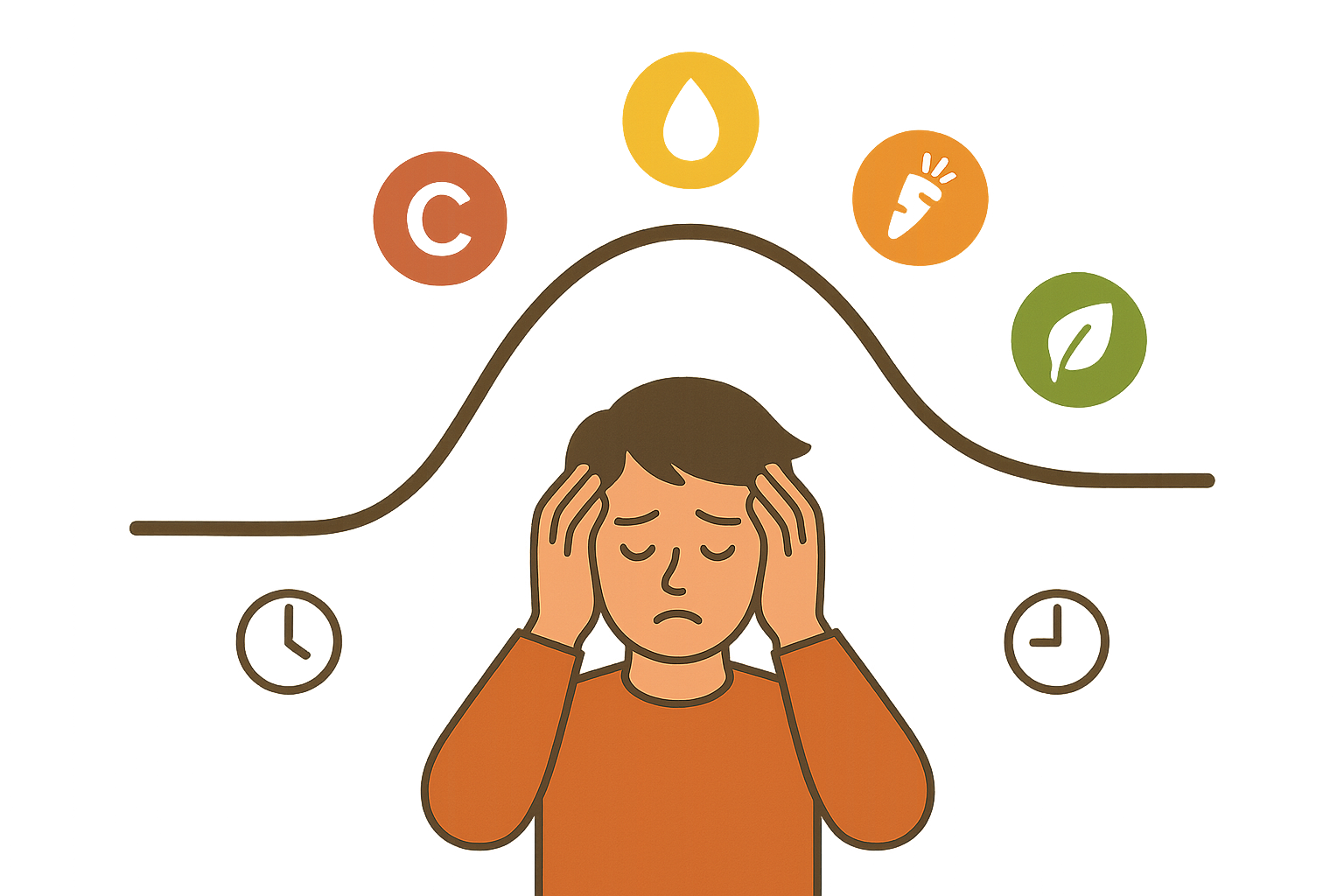
The Hidden Psychology Behind Meal Prep Success
Meal prep isn’t just about cooking food in advance – it’s about understanding how preparation changes your relationship with food choices and reduces the mental load of daily eating decisions.
I spent years thinking meal prep was about efficiency. Turns out, the psychological benefits far outweigh the time savings. When you remove the daily stress of food decisions, you free up mental bandwidth for everything else in your life.
A recent study in the Journal of the Academy of Nutrition and Dietetics found that “frequently ordering takeout or dining out at a restaurant—eating at least two meals prepared outside of the home per day—increases the risk of dying from any cause by nearly 50%” according to Triathlete Magazine, highlighting why systematic meal prep isn’t just convenient—it’s potentially life-saving.
Spreading Mental Energy Across Time
Effective meal prep works by spreading the mental energy required for food decisions across different time periods, preventing the buildup of decision exhaustion that leads to poor choices during busy or stressful moments.
Think about it – instead of making food decisions when you’re hungry, tired, and stressed, you make them when you’re calm, focused, and have time to consider your options. This shift in timing completely changes the quality of your choices.
My Sunday meal prep sessions became sacred time. I put on music, pour a cup of coffee, and make all my food decisions for the week in one focused session. The rest of the week runs on autopilot.
Strengthening Your Connection with Future You
The act of meal prepping creates a stronger psychological bond between your current self and future self, improving long-term decision-making abilities that extend far beyond food choices. This connection helps you make better choices in all areas of life by practicing care for your future needs.
Every time I chop vegetables or portion out proteins during meal prep, I’m actively caring for the version of myself who will be rushing to a meeting on Wednesday afternoon. This practice of future-self care has improved my planning in every area of life.
Using Prep Time as Stress Relief
Meal preparation can function as a meditative practice that actively reduces stress hormones while creating feelings of control and accomplishment. The rhythmic, purposeful nature of chopping, seasoning, and organizing food provides mental benefits that compound the practical advantages of having meals ready.
My meal prep ideas now include techniques that maximize this meditative aspect. I focus on repetitive tasks – washing greens, dicing vegetables, stirring grains – that quiet my mind while my hands stay busy.
The sense of accomplishment from a completed meal prep session carries me through the entire week. There’s something deeply satisfying about opening the fridge and seeing organized, ready-to-eat meals lined up and waiting.
Conquering Flavor Boredom Before It Starts
The biggest reason meal prep fails is getting bored with repeated exposure to the same foods. Understanding and planning for this natural response allows you to create variety systems that maintain efficiency while preventing the boredom that derails your efforts.
With over 95,000 schools serving 29.7 million students daily, institutional meal planning has proven that systematic variety prevents food boredom – the same principles apply to personal meal prep success.
I learned this lesson after my third week of identical chicken and rice bowls. By Thursday, I was ordering takeout just to escape the monotony. Now I build variety into my meal prep system from the start.
Building Meals Around Flavor Powerhouses
Rich, complex flavors create more satisfying meals that actually improve over time rather than becoming boring. Building your meal prep around ingredients like mushrooms, aged cheeses, tomato paste, and fermented foods makes your prepared lunches more appealing than fresh alternatives.
My meal prep game changed when I started incorporating miso paste, fish sauce, and aged parmesan into my base recipes. These ingredients create depth that develops over the days, making Wednesday’s lunch taste better than Monday’s.
Keeping Textures Interesting All Week Long
Different textures change in predictable ways during storage, and understanding these patterns allows you to design meals that maintain sensory appeal throughout the week. Strategic texture planning prevents the soggy, unappetizing results that make people abandon their meal prep efforts.
A chef friend developed a “texture timeline” system: Day 1-2 for crispy elements (roasted vegetables), Day 3-4 for tender proteins (braised meats), and Day 5-7 for grain-based dishes that improve with time. This approach maintains meal satisfaction throughout the week.
I adopted a similar system in my meal prep routine. Crunchy elements get packed separately and added just before eating. Grains and legumes actually taste better after a few days of marinating in their seasonings.
Rotating Cultural Flavor Themes
Cycling between different cultural flavor profiles (Mediterranean, Asian, Latin American) within your meal prep routine provides psychological variety while using similar base ingredients and cooking techniques. This system gives you the perception of diverse meals without the complexity of completely different recipes.
My meal prep ideas rotate through five cultural themes each week. The same roasted vegetables and grilled protein get completely different treatment depending on whether I’m in Mediterranean mode (olive oil, herbs, lemon) or Asian mode (sesame oil, ginger, soy sauce).
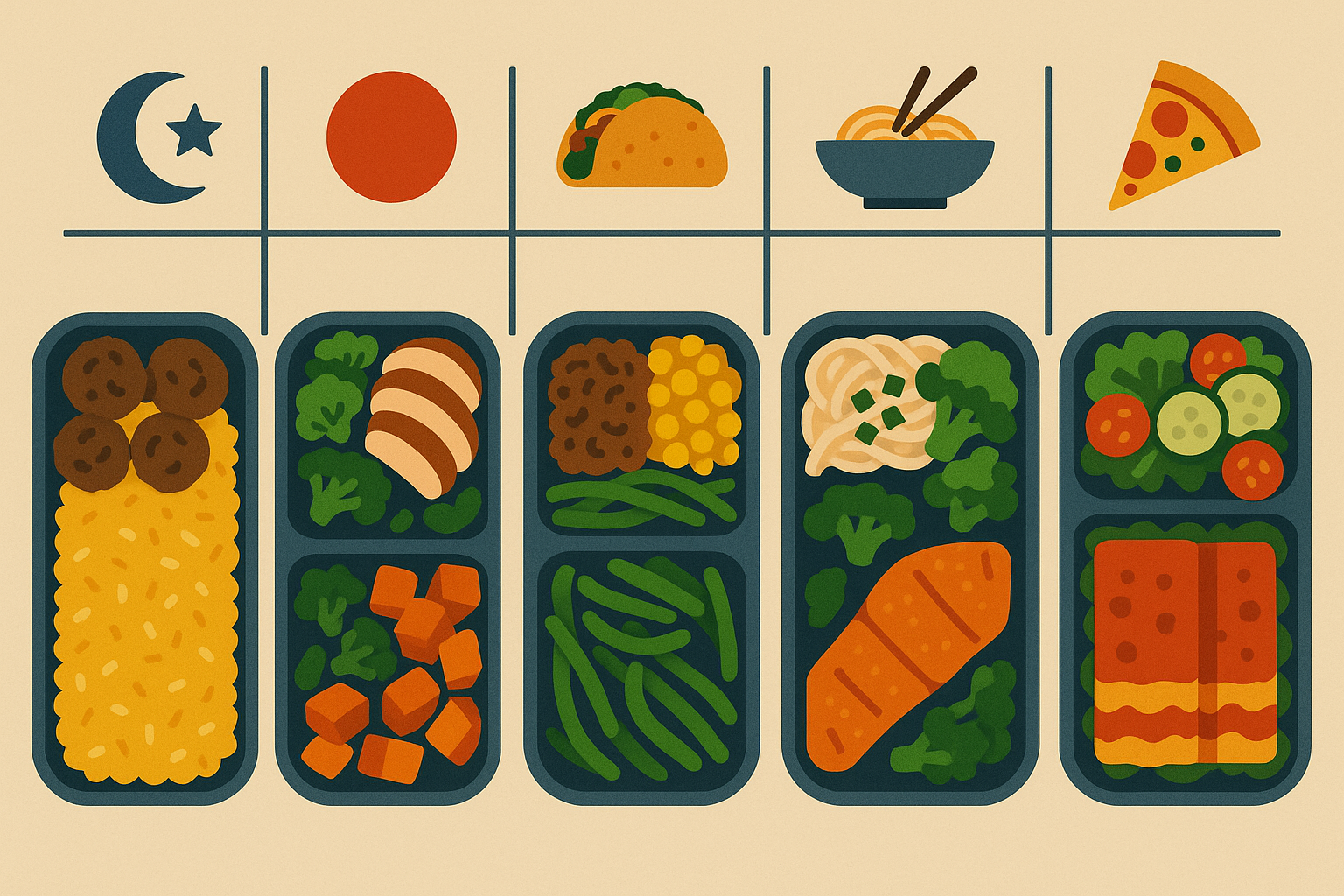
How Your Office Environment Hijacks Your Food Choices
Your lunch decisions don’t happen in a vacuum – they’re constantly influenced by complex social and environmental factors that traditional meal planning completely ignores. Understanding these invisible influences allows you to design eating strategies that work with your real-world circumstances.
I used to blame my willpower when my healthy lunch plans fell apart at work. Turns out, my office environment was systematically undermining my best intentions through subtle psychological triggers I didn’t even notice.
The smell of someone’s pizza delivery, the communal candy bowl, the colleague who always suggests grabbing burgers – these aren’t random temptations. They’re predictable environmental factors that you can plan for once you recognize their patterns.
Navigating Workplace Food Culture
Every workplace has an unspoken food culture that powerfully influences eating behaviors through social pressure, shared rituals, and group dynamics. Successful lunch planning requires understanding and strategically working within these social forces rather than trying to ignore or fight against them.
My office had an unwritten rule that declining lunch invitations was antisocial. I learned to navigate this by suggesting restaurants with healthy options or offering to bring something to share during office celebrations. My meal prep strategy now includes backup social meals for unexpected invitations.
Handling the Business Lunch Balancing Act
Professional lunch meetings and food-centered workplace social interactions create unique challenges that require flexible planning strategies. You need systems that maintain your health goals while honoring professional relationships and social expectations without appearing antisocial or high-maintenance.
I keep a mental list of restaurants near the office with options that align with my meal prep goals. When someone suggests lunch, I can quickly recommend places where I can stay on track without making a big deal about my dietary choices.
Redesigning Your Food Environment
Your workplace contains countless environmental cues that trigger unconscious eating behaviors – from the smell of someone’s takeout to the location of vending machines. Strategic lunch planning includes identifying and modifying these environmental triggers to support better choices.
Common Office Food Triggers and Solutions:
- Office candy bowl: Replace with nuts or remove entirely
- Vending machine proximity: Pack backup healthy snacks
- Communal kitchen smells: Eat planned lunch before exposure
- Meeting room pastries: Bring alternative to share
My office had this evil candy bowl right by the printer. Every time I made copies, there it was, whispering sweet nothings about chocolate. I finally started packing extra nuts in my lunch bag as backup. Problem solved.
Adapting to Nature’s Changing Demands
Your nutritional needs, appetite patterns, and food preferences naturally shift with seasons, daylight exposure, and temperature changes. Effective meal planning works with these biological rhythms rather than fighting against them with rigid, year-round systems.
Nutrition experts emphasize that “meal prepping should mean readying an array of nourishing recipes that’ll keep you interested” according to Bon Appétit, highlighting the importance of seasonal variety in maintaining long-term meal prep success.
Winter months had me craving heartier, warming foods while summer called for lighter, cooling meals. My meal prep approach now shifts with the seasons instead of fighting these natural preferences.
How Light Exposure Controls Your Hunger
The amount and quality of natural light you receive directly impacts hunger hormones and food cravings in predictable ways. Seasonal meal planning accounts for these light-driven changes in appetite and energy needs, adjusting your lunch strategy as daylight hours shift throughout the year.
During darker winter months, I noticed my meal prep needed to include more vitamin D-rich foods and mood-supporting nutrients. The shorter days triggered different cravings that my summer meal prep ideas couldn’t satisfy.
Syncing with Local Food Rhythms
Aligning your meal planning with local seasonal food availability not only improves nutrition and flavor but also reduces decision fatigue by naturally limiting choices to what’s optimal at any given time. This connection to local food systems creates a sustainable framework that changes appropriately throughout the year.
Shopping at farmers markets transformed my meal prep routine. Instead of overwhelming grocery store choices, I work with whatever’s in season locally. This constraint actually makes meal prep easier while improving the quality of my ingredients.

Building a Bulletproof Lunch System That Actually Works
I stopped trying to copy Pinterest-perfect meal prep and started asking: What actually works for MY messy life? Turns out, five simple lunch templates and Sunday vegetable prep was my sweet spot. No fancy containers or color-coded systems required.
After years of failed attempts, I realized the problem wasn’t my willpower or motivation – it was trying to force generic systems onto my specific life circumstances. Success came when I stopped copying other people’s meal prep routines and started designing my own.
The breakthrough happened when I treated my lunch planning like a work project. I analyzed my constraints, defined what success actually looked like, and built in failure recovery protocols from the start.
Creating Your Personal Food System
Successful meal planning isn’t about following someone else’s system – it’s about developing your own decision-making process that automatically guides choices based on your unique circumstances, preferences, and goals. These personal systems eliminate decision exhaustion while ensuring your approach actually fits your life.
My meal prep system considers five factors: available time, energy level, ingredient freshness, upcoming schedule, and current stress levels. This framework makes decisions automatic without requiring conscious willpower each time.
Working Within Your Constraints (Not Against Them)
Instead of trying to plan around unlimited options, successful meal planning starts with identifying and embracing your specific constraints – time, budget, cooking skills, storage space, family preferences. Designing systems that work within these limitations creates sustainable success rather than constant frustration.
With 96.8% of school districts reporting that unpaid meal debt is a challenge, even institutional food programs face budget constraints that require systematic planning – demonstrating why personal budget-conscious meal planning is essential for long-term success.
I spent months fighting against my tiny kitchen and limited storage space before accepting these as design parameters rather than problems to solve. My meal planner now works perfectly within a 4-container rotation system that fits my actual refrigerator space.
Personal Constraints to Consider:
- Available prep time per week (be realistic)
- Weekly food budget (including emergency meals)
- Storage space (refrigerator, freezer, pantry)
- Cooking equipment and skills
- Family dietary restrictions or preferences
- Work schedule and meeting patterns
- Transportation/lunch storage options
Planning for Failure Before It Happens
Your system will break down. Mine does every few weeks when life gets crazy. The difference now? I have a backup plan instead of a guilt spiral. Keep some decent frozen meals around and call it a day.
Anticipating the specific ways your meal planning system is likely to break down allows you to build backup systems and recovery protocols that prevent complete derailment. This failure planning turns temporary setbacks into minor inconveniences rather than system-ending disasters.
Don’t be like me and try to prep 20 mason jar salads on your first Sunday. They got soggy, I got overwhelmed, and I ordered pizza by Wednesday. Start small, people.
My meal prep ideas now include what I call “disaster meals” – simple combinations that require zero cooking when my regular system breaks down. Canned beans, pre-cooked grains, and bagged salads become lifesavers during chaotic weeks.
Defining What Success Actually Looks Like
Clear, measurable definitions of successful meal planning for your specific situation allows you to iterate and improve your system over time. Without concrete success metrics, you can’t tell if your system is working or needs adjustment.
For me, success means eating a planned lunch 80% of weekdays, spending less than 2 hours on weekend meal prep, and maintaining steady energy until 4 PM. These specific metrics help me evaluate and adjust my lunch meal plan objectively.
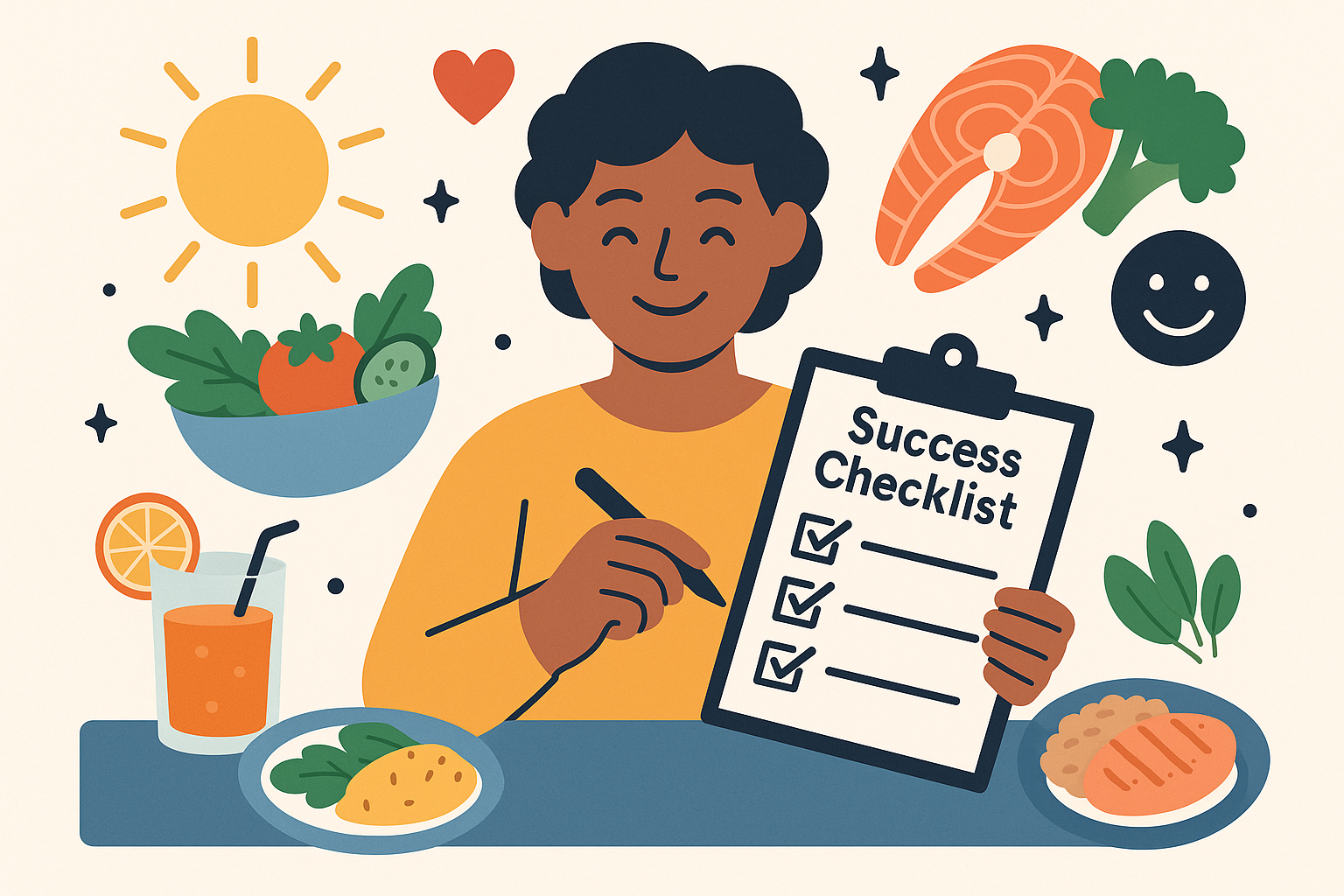
The 30-Day Integration Process
Successfully implementing a new lunch meal planning system requires a structured approach that gradually builds habits while maintaining flexibility for real-world challenges. This systematic integration process starts simple and adds complexity based on real-world feedback rather than overwhelming you with perfection from day one.
Rushing into elaborate meal prep routines sets you up for failure. I learned this after multiple attempts at complex systems that collapsed within weeks. This process builds sustainable habits by adding one element at a time.
Week 1: Just Notice What You’re Eating
Spend the first week tracking your current lunch habits without changing anything. Document what you eat, when, where, how you feel afterward, and what influenced each decision. This baseline data reveals your actual patterns rather than what you think you do.
The tracking phase shocked me. I thought I was making decent lunch choices, but the data showed I was buying takeout 60% of the time and experiencing energy crashes almost daily. You can’t improve what you don’t measure accurately.
Week 1 Tracking Questions:
- What time did I eat?
- What did I actually consume?
- Where was I?
- How did I feel 2 hours later?
- What influenced this choice?
Week 2: Pick Your Biggest Problem
List all your limitations – time, budget, cooking skills, storage space, family needs – and rank them by impact on your lunch decisions. Design your initial system to work within your top three constraints rather than trying to solve everything at once.
My top constraints were limited prep time, small refrigerator space, and unpredictable meeting schedules. Accepting these limitations helped me design a meal prep system that actually worked instead of fighting against reality.
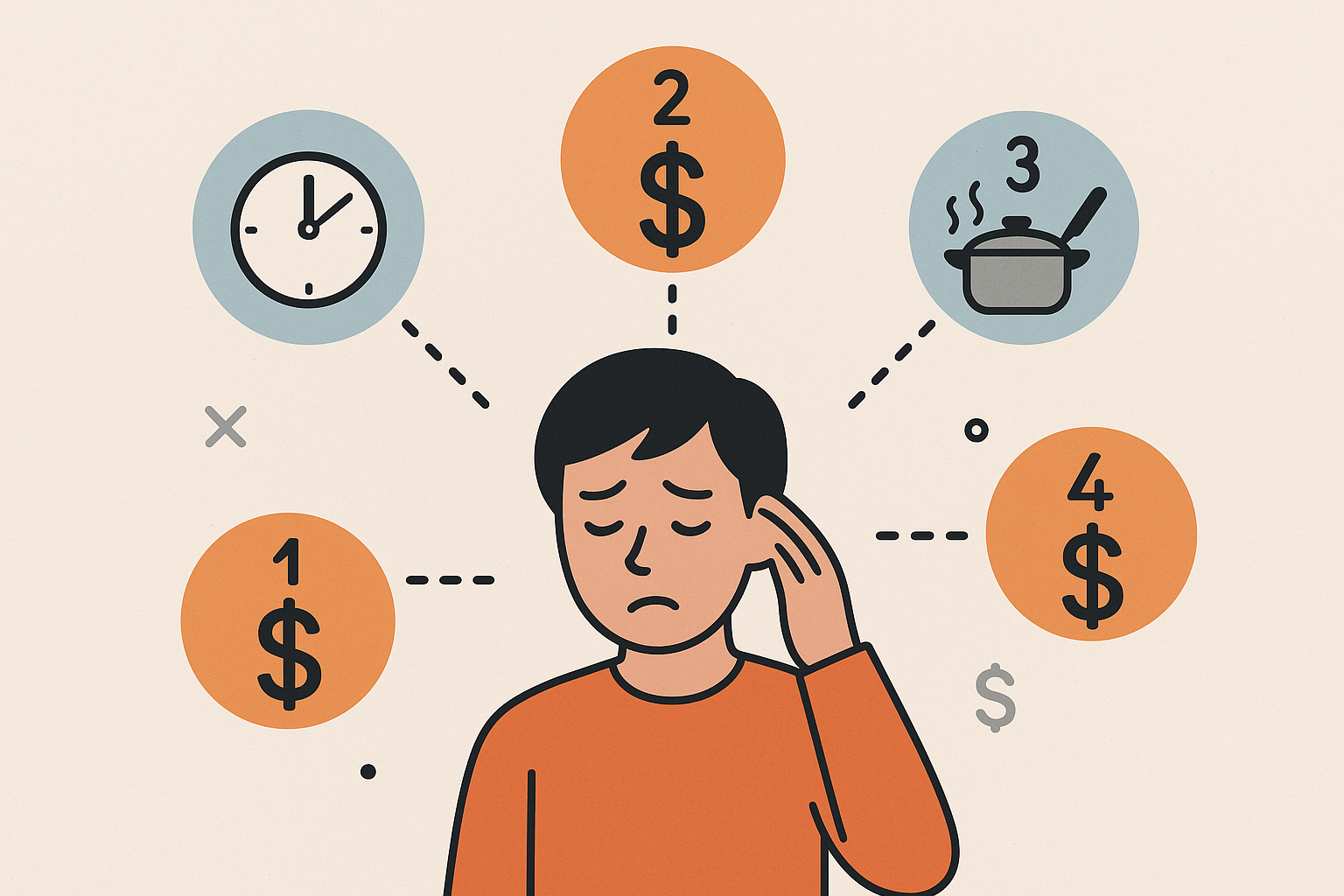
Week 3: Try ONE Simple Solution
Decide whether you’ll plan daily, weekly, or monthly based on your lifestyle and preferences. Most people succeed with weekly planning done on the same day each week, but your rhythm needs to match your natural planning style and schedule realities.
I tried daily planning first but found it exhausting. Weekly planning on Sunday mornings became my sweet spot – enough structure to eliminate daily decisions but flexible enough to adjust for changing circumstances.
Week 4: Adjust Based on What Actually Happened
Create 3-5 lunch templates that you genuinely enjoy and can easily modify with different ingredients. Focus on mastering these core templates before adding variety – this foundation prevents decision fatigue while you build the habit of systematic planning.
My five templates became: grain bowls, soup and salad combinations, wrap variations, leftover transformations, and emergency assembly meals. Each template has multiple ingredient variations but follows the same basic structure.
Week 5: Build Your Prep Routine
Establish a consistent meal prep routine that fits your actual schedule, not an idealized version of your time. Start with minimal prep – maybe just washing vegetables or cooking grains in bulk – and gradually increase complexity as the habit solidifies.
I started with just 30 minutes of Sunday prep: washing greens, cooking one grain, and chopping vegetables. This minimal routine felt manageable and gradually expanded as the habit strengthened. Consistency over perfection became my mantra.
Week 6: Create Your Recovery Protocols
Plan specific actions for when your system breaks down (and it will). Have backup meals identified, emergency options ready, and clear restart procedures written down. These recovery protocols turn inevitable setbacks into minor speed bumps rather than complete system failures.
Emergency Lunch Backup Plan:
- 3 backup meals requiring less than 10 minutes prep
- List of healthy delivery/takeout options
- Grocery store grab-and-go alternatives
- Office emergency snack stash locations
- Recovery restart procedure (written steps)

How does your current lunch routine make you feel at 3 PM? If you’re experiencing afternoon energy crashes or constantly stressed about food decisions, it might be time to examine whether your approach is working with or against your natural rhythms.
Organic Authority understands that true wellness comes from systems that support your whole life, not just individual healthy choices. Their bioavailable marine collagen integrates seamlessly into planned lunch systems – adding it to soups, grain bowls, or smoothies provides skin, hair, and nail benefits without disrupting your carefully crafted meal routines. When you’re building sustainable wellness habits, every element should work together rather than requiring separate willpower.
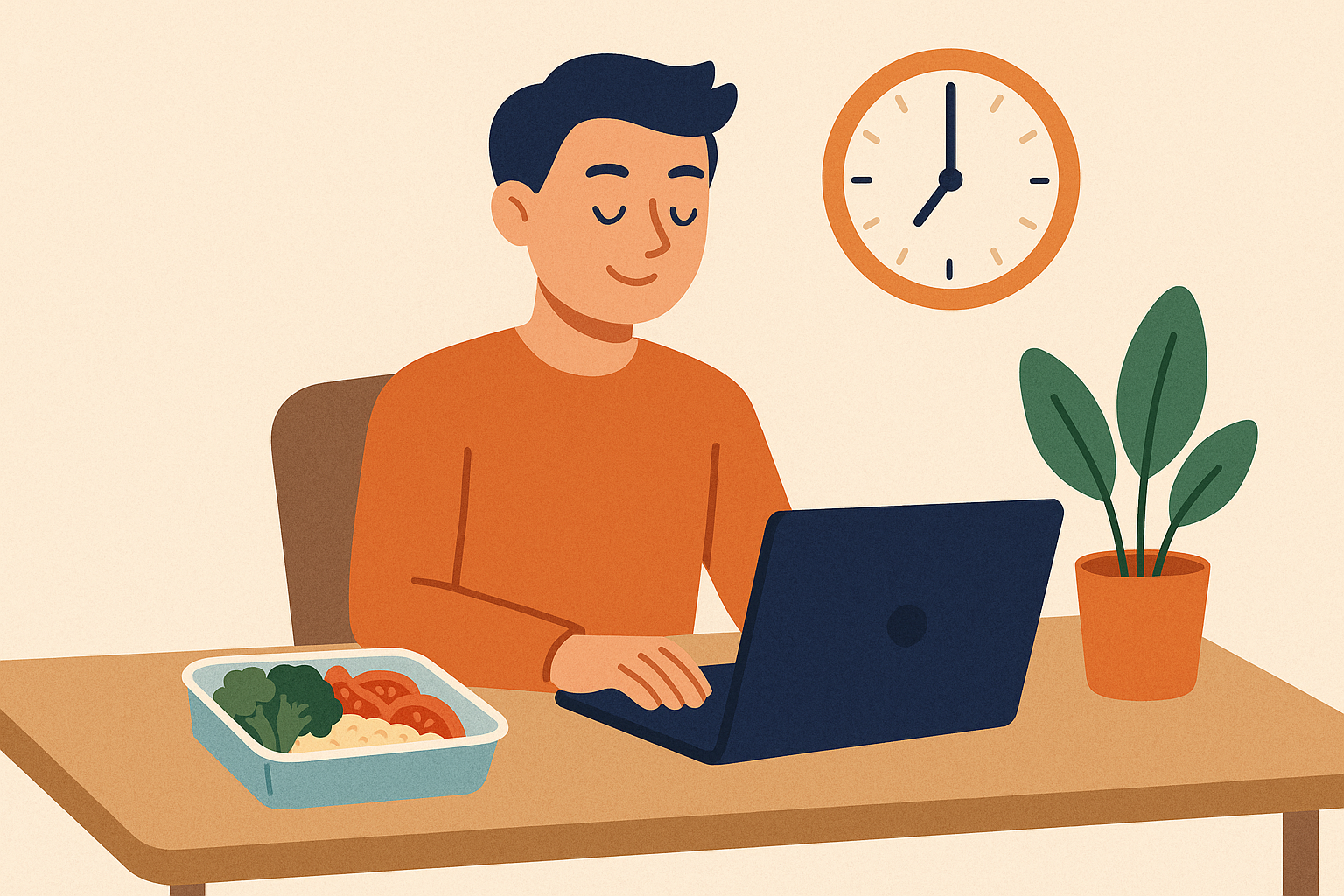
Final Thoughts
Listen, perfect meal planning is a myth. But having a loose system that works 80% of the time? That’s life-changing.
Transforming your lunch meal plan isn’t about perfect execution or following someone else’s system exactly. It’s about understanding how your unique biology, psychology, and circumstances interact with food decisions, then building personalized systems that make good choices automatic rather than effortful.
The most successful approach combines understanding of your body’s natural rhythms and decision exhaustion with practical strategies for meal prep and environmental design. When you stop fighting against your natural patterns and start working with them, lunch planning becomes a tool for enhancing your entire day rather than just another task to manage.
Start with whatever feels doable from this post – whether that’s understanding when your body actually wants food, reducing decision exhaustion, or building better prep systems. Small, consistent changes in how you approach lunch can create ripple effects that improve your energy, productivity, and overall relationship with food throughout the day.
Your afternoon energy levels will thank you.

